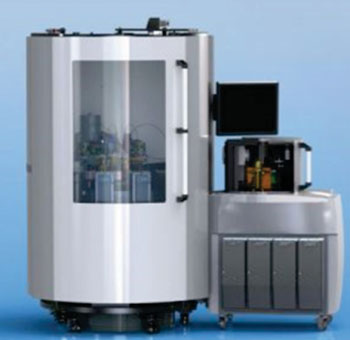Hyperpolarized Carbon Technology Enables Researchers to See Cell Activity in Real Time
By LabMedica International staff writers
Posted on 04 Jun 2014
A newly devised hyperpolarizing system works by controlling the power of hyperpolarized carbon 13C (C-13), so that researchers can now see metabolic biochemical changes in cells as they occur.Posted on 04 Jun 2014
At the joint meeting of International Society of Magnetic Resonance in Medicine (ISMRM) and the European Society of Magnetic Resonance in Medicine and Biology (ESMRMB) on May 13, 2014, held in Milan (Italy), GE Healthcare (Chalfont St. Giles, UK) introduced SPINlab, a hyperpolarizing system that enables the visualization of metabolic activity at the cellular level using magnetic resonance imaging (MRI). The system streamlines MRI metabolic research by providing efficient access to hyperpolarized compounds in a dedicated unit. SPINlab is the inaugural product of Research Circle Technology, Inc. (RCT; Tucson, AZ, USA), which GE introduced in 2011 to enhance development of innovative technology, in collaboration with leading scientists.

Image: The SPINlab platform (Photo courtesy of GE Healthcare).
The hyperpolarization system that was first used several years ago needed an entire clean room; additionally, it required substantial amounts of liquid helium to operate and several operators working in concert. SPINlab is now the first high-throughput, fully-automated hyperpolarizer that requires minimal helium. It has an integrated fluid path, quality control system, and simultaneously hyperpolarizes multiple samples of pyruvate or other compounds to produce imaging agents.
Nearly all the major diseases are in some way tied to metabolic alterations. The introduction of SPINlab has expanded new possibilities to study non-invasively the biochemical changes in disease processes by improving the sensitivity of MRI by more than 20,000-fold. By using SPINlab, researchers can study the real-time metabolism of disease, going further than morphology and functionality to reveal visual data about the flow, metabolism, perfusion, and organ and cell viability in living creatures. Because SPINlab enables noninvasive imaging of metabolic pathways, it allows researchers to better study treatment monitoring and earlier disease detection.
Global imaging technology specialists and disease detection research are now exploring potential applications for metabolic imaging technology. Investigators from the University of California- San Francisco’s (UCSF; USA) Surbeck Laboratory for Advanced Imaging completed a 31-patient study. “We now have a safe dose for patients—that was our primary goal,” said Sarah J. Nelson, PhD, a UCSF professor of radiology and director of the Surbeck Laboratory of Advanced Imaging at UCSF, who was lead author on the study and led a diverse team on this project. These findings were published online in the August 14, 2013, issue of the journal Science Translational Medicine.
Scientists from Cancer Research UK’s Cambridge Research Institute have developed a technique to show the effectiveness of cancer treatment weeks earlier than current methods through metabolic imaging. “We think this technique may be able to guide therapy,” said Lead Research Professor Kevin Brindle. “We are hoping that it will lead to patients not having to take drugs that will not work for them. There are treatment choices—some people respond really well to one treatment, and others don’t. The standard method for assessing whether a treatment has worked is for a patient to take a course of treatment and then determine whether the tumor has shrunk or not. This new technique could allow doctors to tell much more quickly whether a treatment is working.”
“For the past few years, RCT has engaged an open collaboration network of the world’s leading researchers as they studied the applications of hyperpolarized C-13 technology,” said Jonathan A. Murray, managing director, Research Circle Technology. “The SPINlab platform is a tangible result of that effort; it is the industrialized solution they asked for.”
“RCT is proving to be an effective way to work with researchers,” said Richard Hausmann, president and CEO of GE Healthcare, MRI and member of the board of directors of RCT. “We have been collaborating with sites around the world on this cutting-edge technology that enables their metabolic research. We are very excited to see the results coming from their labs and look forward to future developments that will improve our understanding of cellular metabolic activity.”
Through RCT, GE will provide the tools, services, and solutions so researchers can focus on their investigations into the biochemistry of metabolism and advance the discovery of potentially life-saving knowledge. Output of this technology may only be used for human applications under an approved research study (investigational new drug [IND] or equivalent). SPINlab is not a medical device.
RCT was created to accelerate and enhance the development of new technology.
Related Links:
GE Healthcare
Research Circle Technology
University of California San Francisco













